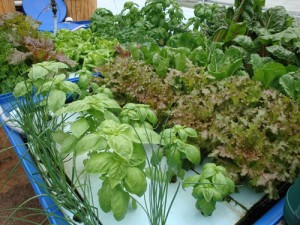
Aquaponics is the ideal answer to a fish farmer’s problem of disposing of nutrient rich water and a hydroponic grower’s need for nutrient rich water. Essentially, aquaponics mimics every natural waterway on earth. It is used to grow food crops in a concentrated, yet sustainable manner.
The main input to an aquaponic system is fish food. The fish eat the food and excrete waste. More than 50% of the waste produced by fish is in the form of ammonia secreted in the urine and, in small quantities, through the gills. The remainder of the waste, excreted as fecal matter, undergoes a process called mineralization which occurs when heterotrophic bacteria consume fish waste, decaying plant matter and un-eaten food, converting all three to ammonia and other compounds. In sufficient quantities ammonia is toxic to plants and fish.
 Nitrifying bacteria, which naturally live in the soil, water and air, convert ammonia first to nitrite and then to nitrate which plants consume. In an aquaponic system the heterotrophic and nitrifying bacteria will attach to the tank walls, underside of the rafts, organic matter, the growing medium (if used) and in the water column. The beneficial bacteria discussed here are natural and will inhabit an aquaponic system as soon as ammonia and nitrite are present.
Nitrifying bacteria, which naturally live in the soil, water and air, convert ammonia first to nitrite and then to nitrate which plants consume. In an aquaponic system the heterotrophic and nitrifying bacteria will attach to the tank walls, underside of the rafts, organic matter, the growing medium (if used) and in the water column. The beneficial bacteria discussed here are natural and will inhabit an aquaponic system as soon as ammonia and nitrite are present.
Essentially, you have three crops to keep alive in aquaponics; the fish, the plants and the beneficial bacteria. These three living entities each rely on the other to live. The bacteria consume the fish waste keeping the water clean for the fish. In the process, the bacteria provide the plants with a usable form of nutrients. In removing these nutrients through plant growth, the plants help to clean the water the fish live in.
Aquaponics is a very efficient method of growing food that uses a minimum of water and space and utilizes waste, resulting in an end product of organic, healthful fish and vegetables. From a nutritional standpoint, aquaponics provides food in the form of both protein (from the fish) and vegetables.
